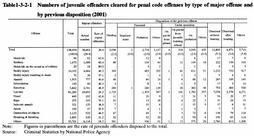| Previous Next Index Image Index Year Selection | |
|
|
The percentage of repeat offenders among all juvenile offenders continued to decrease from 1992 to 1997, and then turned upward (see Fig. 1-3-1-1 ).
Table 1-3-2-1 shows the number of juvenile offenders cleared for penal code offenses excluding professional negligence in traffic accidents in 2001 by type of major offense and by previous disposition (For the treatment of juvenile offenders, see Part 4, Chapter 2 ). Table 1-3-2-1 Numbers of juvenile offenders cleared for penal code offenses by type of major offense and by previous disposition (2001) As for juveniles cleared of heinous offenses such as homicide and robbery, or violent offenses such as bodily injury, extortion and rape, the repeat offender rate that is the percentage of juveniles who had previously been cleared had a high share.Viewed in connection with previous dispositions, the percentage of juveniles who had been disposed as dismissal without or after hearing was the highest. This resulted from the fact that most juvenile offenders are disposed as dismissal without or after hearing. However, as for juveniles cleared for the offenses mentioned above that were frequently committed by repeat offenders, the percentage of those who were under probationary supervision was high when they committed the offenses. As for juveniles cleared for homicide, robbery, bodily injury, etc., the rate of juveniles whose previous disposition was termination of probationary supervision was high. These facts suggest that juveniles who were cleared for heinous or violent offenses had been considered that protective measures should be adopted for them before they committed the latest offense. |
